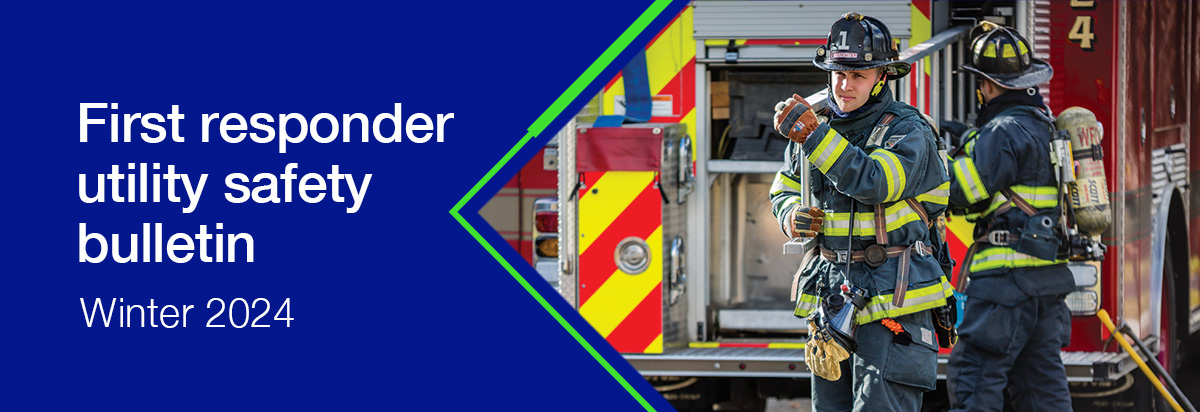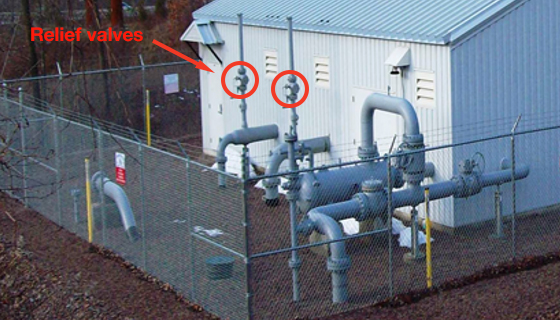| View in browser > |
 |
| Understanding relief valves: Essential practices for first responders |
|
Relief valves, engineered to prevent system over‑pressurization, are a critical part of the natural gas pipeline system. They actively regulate pressure within the system by opening at a preset pressure to vent excess gas and vapors and then by closing once the pressure is back within a safe range. These mechanical safety devices, though small, play a large role in protecting not only the system but also the community. |
|
|
 |
| Dedicated relief valves are typically present in high‑pressure distribution stations and at pressurized storage locations. |
|
If the system does not vent properly, the resulting pressure buildup could lead to system failure. The consequences of a system failure could be as minor as a temporary gas outage or as catastrophic as an explosion. This is why first responders should NEVER attempt to operate these valves or restrict the associated vents in any way. |
| How do you investigate a pressure release? |
|
Be proactive. A natural gas event should not be your introduction to relief valves in the communities you serve. Partner with National Grid preemptively to learn the location of valves within their facilities. |
|
Ask questions. Obviously, a natural gas emergency may not be the optimal time to ask dispatched National Grid personnel for valve safety education and training. Communication between you and utility personnel prior to an event is essential to valve safety. Ensure that you understand the basics of relief valve function and behaviors, but most importantly, NEVER operate or restrict pressure relief valves in any situation. Query utility personnel about any concerns and uncertainties you may have so that you are well informed and prepared. |
|
Train. Knowing how to respond to normal and abnormal pressure release events helps protect not only you and your crew but also your community and the environment. The more informed and trained you are, the more effective you can be at managing a release event. |
|
What do you do when dispatched to investigate a pressure release? |
|
Contact and work with the utility. When dispatched to investigate, notify the utility and request the response of a subject matter expert (SME) to work in partnership with first responders as a member of the command team. Work with the onsite SME to: |
| • |
 |
Perform a predictive analysis of prevailing wind patterns and conditions to determine odorant and vapor‑cloud migration. |
|
| • |
 |
Set up appropriate safety/exclusion zones and monitor critical areas. |
|
| • |
 |
Identify priority risks and target hazards, such as control stations, neighborhoods close to potential event areas or highways that could be ignition sources. |
|
| |
 |
Important: NEVER enter control stations, and NEVER operate or change the settings of pipeline, storage or control station valves of any type. Only trained utility operators should open or close these valves. However, if trained to do so, you can stop the flow of gas by closing the aboveground shutoff valve at a service meter or the shutoff valve at an appliance line. |
|
| |
|
|
Engage with the community. Even a small release of natural gas through a relief valve, which may be a normal operating condition, will often result in community concern – or even panic – stemming from the sulfur-like or rotten‑egg smell of mercaptan. During any pressure release event, you should work with the utility to distinguish between normal and abnormal (emergency) situations. |
|
The discharge sounds, odorants and vapor clouds produced from the valves can be alarming to the public – and rightfully so. Once the utility has confirmed that the event is nonthreatening: |
|
|
| • |
 |
Continue to take public concern seriously and choose a single-source contact for public communication, such as through some form of media. |
|
| • |
 |
Reassure the community about the behavior of the relief valve as a safety device operating as designed to relieve pressure from the pipeline system. |
|
| |
|
|
If a relief valve continues to actuate for an extended period, the odorant released will likely heighten community concern. Therefore, consider placing firefighting apparatus and utility resources in the area as a proactive tactic and a demonstration of fire service presence to ease these potential concerns. |
|
As a proactive measure, initiate safety awareness programs about relief valves within the community. Use these programs to explain the purpose and behaviors of the valves and established safety measures. |
| Keep yourself, your team and the public safe this winter and year‑round. Visit firstresponder.ngridsafety.com today to register and complete your utility safety training. |
|
|
|
| |
| |
|
| To report emergencies, call 911 and National Grid immediately. |
| |
 |
| In case of gas emergencies: |
 |
Long Island and the Rockaways:
911 and 1‑800‑490‑0045 |
 |
Metro New York:
911 and 1‑718‑643‑4050 |
 |
Upstate New York:
911 and 1‑800‑892‑2345 |
 |
Massachusetts:
911 and 1‑800‑233‑5325 |
 |
| |
|
|
|
|
| |
|
|
|
| |
| |
|
 |
#14238 © 2024 Culver Media, LLC |
|
| |
|
|
|
 |
|
|